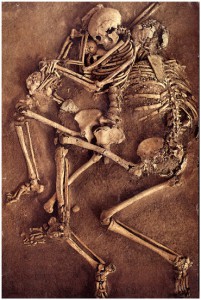
Photo courtesy of Noelle Soren and David Soren, 2008
Look at this picture!
While browsing through internet pages and social media, I came across this picture and it somehow got stuck in my mind. These skeletons were found by two archeologists, David Soren and Noelle Soren in the mid-1980s in a Roman house in Kourion, Cyprus. They are believed to be killed during an earthquake that struck Kourion in 365 AD. The picture includes a family of three, showing a mother cradling an infant in her arms as the father trying to protect them from the falling debris. Being a structural engineer, I felt this picture posing a question to me, what we have achieved in last 2000 years in terms of being resilient to earthquakes?
So in a quiet evening, while sitting alone in office, I start trying to somehow satisfy these three souls, telling them about our advanced nonlinear structural modeling techniques, seismic analysis procedures and earthquake resistant design of buildings. Of course, the knowledge of seismic activities and associated loss of lives and property, expanded exponentially over the last few decades but can we really claim to be victorious over these monsters? To what extent we are more confident about our safety compared to 2000 years back? After every big event, Mother Nature answers these questions in a manner hard to digest.
Being born and raised in Pakistan, a seismically active part of the world, the fear of earthquakes was always a definite part of my cultural memory. However the most unforgettable experience was a 7.6 magnitude Kashmir earthquake on 8 October 2005 which jolted the northern part of country, turning thousands of small houses into rubble. Innumerable residential and commercial buildings were collapsed catastrophically rendering more than half a million homeless survivors beside an official figure of 90,000 deaths. The day was also my first day of undergraduate studies in Civil Engineering. While working with emergency relief agencies, I can remember the painful sights of damaged structures in areas where more than 90% of the people believed that it happened because someone on the skies is not happy with them. I can still remember how hard it was to explain a poor villager why he should not build an unreinforced stone masonry wall again for his house. How surprised was he listening to my words. How could he be sitting for whole of his life on a time-bomb which can explode any time, on the boundary of Indian and Eurasian tectonic plates? Those visuals somehow refused to disband from my mind.
But here we are, again jolted by the same monster, again facing the wrath of Mother Nature. The visuals and CCTV camera footages from magnitude 7.8 Nepal Earthquake on 25 April 2015 don’t seem much different to me. Every hour, with new pictures of damaged buildings on social media, I am sitting in my university office googling the news to check death toll, in imagination trying to explain those souls why after 2000 years, they still have to die like Kourion family. While my colleagues are discussing and identifying building damage patterns in media photographs, I am having a hard time in concluding how long will it take for our huge knowledge databases and collective intellect to result in a strong realization among common people that the structures they erect after a lifelong economic struggle can become the token of their deaths. Yes, there will be seminars, conferences, discussions among the peers around the globe, new papers will be published and the profession will continue to grow. Yet most of such questions will remain unanswered for years to come.
The story ends in a small museum in Episkopi on the island of Cyprus where the skeletons of Kourion family are resting in peace, the nineteen year old mother cradling her eighteen month old baby in her arms, while her husband trying to protect them from the falling debris.
Author: Fawad Ahmed Najam Asian Institute of Technology, Bangkok, Thailand
